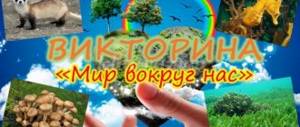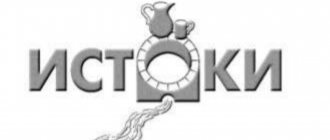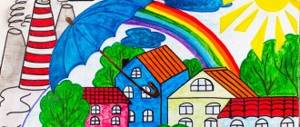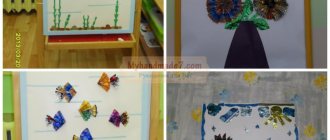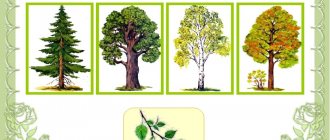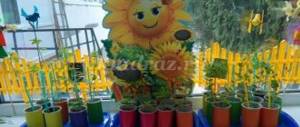Diagnostics of environmental education of preschool children
⇐ PreviousPage 19 of 20Next ⇒Ecological and pedagogical work with children during the school year gives clear results in each age group. An experienced teacher notices them “by eye,” but a specially carried out diagnosis makes it possible to more objectively, more thoroughly and accurately record changes in the environmental education of each child. What and how is it advisable to check diagnostics?
In the “Young Ecologist” program, there are two main categories - “ecological knowledge” and “attitude”, with the second being the leading and broader one. “Attitude” accumulates knowledge and emotions at the same time and contains intellectual and sensory components. In preschool age, knowledge is important not so much in itself, but as a means of forming attitudes. Diagnostics should be aimed at identifying both components in children. Knowledge alone should not be identified, since it does not always determine human behavior and often comes into conflict with it. Sometimes a child has certain knowledge, can formulate it, but behaves differently, not in accordance with it.
How do knowledge and attitudes manifest themselves? How to detect them in a diagnostic procedure? Knowledge (conscious) is always verbal. They are easy to detect by asking children questions or presenting them with pictures, objects that they must name, combine, arrange in a certain way, and then explain what and how they did, why they performed these particular operations. You can organize a verbal didactic game, the children’s reactions in which will be a reflection of their knowledge.
Attitude is more difficult to identify, since it manifests itself in different ways: in experiences (and they can be hidden), in positive and negative emotions, in individual actions, systematic behavior and verbally (in questions, messages, in readiness to listen to explanations from adults, in reading books). The most striking manifestations of attitude are behavioral, which combine practical actions or actions, statements, and emotions. Such a palette of relationships can be revealed, as a rule, only in real life situations.
Therefore, the methodology for diagnosing attitudes towards nature should be close to real life. It can be constructed in the form of a natural experiment - specially organized situations in the children’s normal living environment, as well as in the form of diagnostic observation of the real behavior of preschoolers for some time (from one to three weeks). Diagnosis of knowledge should be carried out using the example of those objects and natural phenomena that surround children and are well known to them, with which they have been in long-term contact, with which various types of activities have been organized repeatedly during the school year.
An approximate list of questions about the inhabitants of a corner of nature could be as follows:
• Who lives in our aquarium? What conditions do fish need to feel good and not get sick? How do we care for the aquarium and its inhabitants?
• What indoor plants from our group do you know? Show them, name them. What conditions do these plants need in order for them to grow, bloom, and be beautiful? How do we care for them?
• Who lives in the cage? What is the name of our bird? What conditions are needed for her to feel good and make us happy? How do we care for her? What food should she be given to keep her full and not get sick?
• Who lives in this cage? What is the name of the animal (or animal)? What conditions do we create for him so that he feels good and doesn’t get sick? What can't he do without? How do we care for it?
• Which of the inhabitants of this corner of nature do you especially like? Who do you love the most? Why do you love him (them)? What are you doing for him (them)? Such questions can be asked starting from the middle group. The difference in answers will reflect (in addition to differences in speech development) the different volume and content of knowledge that children acquire at each age. With older preschoolers, such a diagnosis can be carried out in the form of a game of “Excursion to a Corner of Nature”: the child becomes a guide for a new person or doll.
The list of questions regarding the kindergarten site is approximately as follows:
• What grows in our area? What trees and shrubs do you know? Show and name them. What herbs and flowers do you know? Show and name them. What conditions do all the plants in our area need? Why do they grow so well here? Which plants do you like best? Why? What do we do to make plants feel even better?
• What birds fly to our site? What are their names? What are they doing on our site? How do we take care of birds in winter? How can these birds be called in one word? Why should people help birds in winter?
• How do we determine the weather? What is the weather like? What is winter? What phenomena happen in winter? What happens to plants in winter - trees, grass? How do they look? Why don't plants grow in winter? What conditions do they lack?
• What do different animals do in winter? Do all birds stay for the winter? Where are the butterflies, beetles, mosquitoes? What do forest animals do in winter?
The questions can be limited to this list, but they can cover two more topics worked out with children: “Vegetables and fruits” and “Pets.” In this case, the survey is based on those objects that were presented to preschoolers more than once. If the kindergarten is located near a forest, pond, meadow and children visit these ecosystems quite often, then you can find out their knowledge in this area. For example, about a forest one might ask the following: what is a forest? Who lives in it? What grows in it? Do you like to go to the forest? Why? How should every person behave in the forest? Why do you need to follow rules of behavior in the forest?
By identifying children’s attitude to nature, the teacher can conduct, in addition to long-term observations, a natural experiment, for example, in the form of a specially organized situation “The food has run out,” which consists of four stages and is designed to last a whole day. Someone from the administration (for example, the head or senior teacher)1 participates in “acting out” it. In this situation, it is necessary to carefully observe the children, record in detail their reactions and manifestations at all stages, then adults will have an objective impression of the level of environmental education of the group as a whole and of each of the children.
Diagnostics involves mandatory recording of the results obtained. To do this, the teacher starts a special notebook in which he writes down the children’s answers, the characteristics of their behavior, and various emotional manifestations. With long-term observation, these are daily detailed diary entries; during a survey, a table in which the teacher marks the children’s answers with pros and cons. It is advisable to conduct diagnostics of children’s environmental education (individually or frontally) twice a year: in the first weeks of September and the last weeks of May. The recorded and detailed result allows us to analyze what happened to the children at the beginning of the year and what they became at the end of the year, how the system of environmental and pedagogical work influenced them. Based on the diagnostic results, the head and teachers adjust their activities, plan the next stages in the environmental education of preschoolers, in working with their parents, take into account individual characteristics in the development of children,
Test questions 1. What are the features of the technology of environmental education for children in the senior group? What literary core does it have? What are homemade nature books? What role do they play in raising children? 2. How does the technology of “ecological-pedagogical work with children preparatory!” for group school differ from the education system in the senior group? 3. What does reading V. Tanasiychuk’s book “Ecology in Pictures” give children? Why do you need a homemade globe? 4. What is diagnostics of environmental education of preschool children? What did she howl to the igam? How often should it be done? 5. What and why is more important: children’s environmental knowledge or their attitude towards nature? How can you determine children's knowledge? How can we identify their relationship to objects and natural phenomena?
Assignment Make up questions to identify knowledge about domestic animals among children of secondary and preparatory school groups.
Appendix 1. The concept of environmental education for preschool children.
Introduction.
Environmental problems are universal problems of the world's population. Thinning of the ozone shell, global climate change, depletion of the natural soil layer, natural resources, decrease in drinking water supplies and at the same time intensive growth of the planet's population, accompanied by an increase in production capacity, frequent accidents - these are problems that concern every state. Together, they create a continuously deteriorating human environment. The variety of diseases that befell people in the last century is the result of the lack of proper interaction between man and nature. Children are especially sensitive to poor living conditions, polluted water, air, and food. Children in Russia are in particularly unfavorable conditions.
The ecological situation in Russia is, in a number of ways, significantly worse than in the countries of Western Europe and America. Russia is a region of the planet that makes a proven significant contribution to the development and preservation of negative global environmental trends. In Russia, there are significant local environmental disturbances - there are a large number of areas with catastrophically deformed nature, in which soil degradation occurs, siltation of small rivers and freshwater reservoirs occurs, and there is a high concentration of pollutants in the air, water, and soil. Because of these disturbances, the habitats have lost the ability to self-purify and self-recovery; their development is moving towards complete destruction and collapse.
Environmental problems and the catastrophe of humanity are directly related to the process of population education - its insufficiency or complete absence has given rise to a consumerist attitude towards nature. As a result: people chop off the branch on which they sit. The acquisition of ecological culture, ecological consciousness, and thinking is the only way out of the current situation for humanity. This concept is based on leading international and domestic documents: materials of the forum in Rio de Janeiro in 1992, documents of the 1st Intergovernmental Conference on Environmental Education (Tbilisi, 1977) and the International Congress “Tbilisi + 10” (Moscow , 1987), Law of the Russian Federation “On the Protection of the Natural Environment” (1991), “Resolution on Environmental Education”, developed jointly by the Ministry of Education and the Ministry of Environmental Protection and Natural Resources of the Russian Federation (1994).
The concept is based on leading materials in the field of education that are of direct importance to it: the Concept of Preschool Education (1989) and the Concept of General Secondary Environmental Education (1994). The first allows us to assimilate advanced humanistic ideas of the personality-oriented model of education of preschool children and ensure the connection of environmental education with the entire sphere of education of children of this age. The second is a guideline in matters of the content of environmental education in the link that is directly adjacent to the preschool period and thus makes it possible to ensure continuity and interconnection of the two links in the system of continuous environmental education.
As the initial link, environmental education of preschool children has an important social significance for the whole society: the foundations of environmental culture are laid in a timely manner in the human personality, at the same time a significant part of the adult population of the country - workers in the field of preschool education and parents of children - is involved in this process, which, of course, has significance for the general ecologization of consciousness and thinking.
The essence and content of environmental education for preschool children
For preschool pedagogy, environmental education is a new direction that appeared at the turn of the 80s and 90s and is currently in its infancy. Its basic basis is the traditionally established program section “Introducing children to nature,” the meaning of which is to orient young children in various natural phenomena, mainly accessible to direct observation: to teach them to distinguish between plants and animals, to give them some characteristics, in some cases establish cause-and-effect relationships. In the last decade, the work of preschool institutions has focused on instilling in children a caring attitude towards living things - familiarization with nature has taken on an environmental overtone.
Environmental education is a new category that is directly related to the science of ecology and its various branches. In classical ecology, the central concepts are: the interaction of an individual organism with its habitat: the functioning of an ecosystem - a community of living organisms living in the same territory (having therefore the same type of habitat) and interacting with each other. Both concepts, in the form of specific examples from the immediate environment of a preschool child, can be presented to him and become the basis for a developing view of nature and relationships with it.
The interaction of man with nature is the second, extremely important aspect of ecology, which has become the basis of rapidly developing industries - social ecology, human ecology - cannot remain aloof from the knowledge of the modern child. Specific examples of human use of natural resources and the consequences of this impact on nature and human health can be adopted by preschool pedagogy in order to form an initial position on this issue in children.
So, the basis of environmental education is the leading ideas of ecology adapted for school age: the organism and the environment, the community of organisms and the environment, man and the environment.
The goal of environmental education of preschool children is the formation of the beginnings of ecological culture - the basic components of personality, which allow in the future, in accordance with the Concept of general secondary environmental education, to successfully acquire in the aggregate the practical and spiritual experience of interaction between humanity and nature, which will ensure its survival and development.
This goal is consistent with the Concept of Preschool Education, which, focusing on general humanistic values, sets the task of the child’s personal development: to lay the foundation of personal culture in preschool childhood - the basic qualities of humanity in a person. Beauty, goodness, truth in the four leading spheres of reality - nature, the “man-made world”, surrounding people and oneself - these are the values that preschool pedagogy of our time is guided by.
The nature of the planet is a unique value for all humanity: material and spiritual. Material, because together all these components constitute the human environment and the basis of his production activity. Spiritual because it is a means of inspiration and a stimulator of creative activity. Nature, reflected in various works of art, constitutes the values of the man-made world.
The formation of the principles of ecological culture is the formation of a consciously correct attitude directly towards nature itself in all its diversity, towards the people who protect and create it, as well as towards the people who create material or spiritual values based on its wealth. It is also an attitude towards oneself as a part of nature, an understanding of the value of life and health and their dependence on the state of the environment. This is an awareness of your abilities to interact creatively with nature.
The initial elements of ecological culture are formed on the basis of the interaction of children, under the guidance of adults, with the objective-natural world that surrounds them: plants, animals (communities of living organisms), their habitat, objects made by people from materials of natural origin. The tasks of environmental education are the tasks of creating and implementing an educational model that achieves an effect - obvious manifestations of the principles of environmental culture in children preparing to enter school.
They boil down to the following: • creating an atmosphere in the teaching staff of the importance of environmental problems and the priority of environmental education; • creation in a preschool institution of conditions that ensure the pedagogical process of environmental education; • systematic training of teaching staff: mastering methods of environmental education, improving environmental propaganda among parents; • carrying out systematic work with children within the framework of one or another technology, its constant improvement; • identifying the level of ecological culture - real achievements in the intellectual, emotional, behavioral spheres of the child’s personality in its interaction with nature, objects, people and self-assessments.
The content of environmental education includes two aspects: the transfer of environmental knowledge and its transformation into attitude. Knowledge is an obligatory component of the process of forming the principles of ecological culture, and attitude is its final product. Truly ecological knowledge forms the conscious nature of the relationship and gives rise to environmental consciousness.
An attitude built without an understanding of the natural connections in nature, the socio-natural connections of a person with the environment, cannot be the core of environmental education, cannot become the beginning of a developing environmental consciousness, because it ignores objectively existing processes and relies on the subjective factor.
The biocenter and approach to environmental education, which puts nature at the center of attention and considers humans as part of it, puts forward the need to study the patterns that exist in nature itself. Only their thorough knowledge allows a person to correctly interact with it and live according to its laws.
This is all the more important for Russia, whose specific features are its large extent and geographical diversity. The historically established reverent attitude of the peoples of Russia towards nature is currently represented by a pronounced environmental trend in education. It can also be noted that the term “environmental education”, which is accepted throughout the world and which reflects anthropocentric tendencies in the relationship between man and nature, has not taken root in Russia. The term “ecological education”, which combines the study of nature, its protection, human interaction with nature, and the environment, corresponds to Russian specifics and the solution of existing environmental problems through education.
The study of the laws of nature can begin in preschool childhood as part of environmental education. The possibility and success of this process has been proven by numerous psychological and pedagogical domestic studies.
In this case, the content of ecological knowledge covers the following range: • the connection of plant and animal organisms with their habitat, morphofunctional adaptability to it; connection with the environment in the processes of growth and development; • diversity of living organisms, their ecological unity; communities of living organisms; • man as a living being, his habitat, which ensures health and normal functioning; • use of natural resources in human economic activity, environmental pollution; protection and restoration of natural resources.
The first and second positions are classical ecology, its main sections: autecology, which considers the life activity of individual organisms in their unity with their environment, and synecology, which reveals the peculiarities of the life of organisms in community with other organisms in the common space of the external environment.
Familiarization with specific examples of plants and animals, their mandatory connection with a certain habitat and complete dependence on it allows preschoolers to form initial ideas of an ecological nature. Children learn: the mechanism of communication is the adaptability of the structure and functioning of various organs in contact with the external environment. By growing individual specimens of plants and animals, children learn the different nature of their needs for external components of the environment at different stages of growth and development. An important aspect in this regard is the consideration of human labor as an environment-forming factor.
The second position allows you to introduce children to groups of living organisms - to form initial ideas about some ecosystems and the food dependencies that exist in them. And also to bring an understanding of unity to the diversity of living nature - to give an idea of groups of similar plants and animals that can only be satisfied in a normal living environment. Children develop an understanding of the intrinsic value of health and the first skills of a healthy lifestyle.
The fourth position is elements of social ecology, which make it possible to demonstrate, using some examples, the consumption and use of natural resources (materials) in economic activities. Familiarization with these phenomena allows children to begin to develop an economical and caring attitude towards nature and its riches.
All designated positions of the content of environmental knowledge for preschool children are consistent with the content of the general educational field “Ecology”, presented in the Concept of general secondary environmental education. The stage of preschool childhood can be considered in terms of its propaedeutics.
Ecological knowledge intended for children corresponds to the moment of “truth” in universal human values. Children acquire “goodness” and “beauty” in the process of transforming knowledge into attitude.
“Attitude” - The end result of environmental education
The transfer of environmental knowledge is the initial stage in the procedure for developing the right attitude towards the world around us. Their transformation is carried out as a result of the teacher’s use of personality-oriented methods of working with children. A clear form of expression of attitude is the child’s activity. The presence of elements of environmental information in the content of an activity serves as an indicator of its attitude to the natural world, things, people and oneself. The attitude of different children is heterogeneous: a cognitive, aesthetic or humanistic component may predominate in it.
The predominance of the cognitive aspect in relation is a pronounced interest in phenomena and events in nature. We can talk about the aesthetic orientation of an attitude if the child’s attention is focused on the external (sensory) qualities of the phenomenon, which entails value judgments. With a clearly expressed humanistic orientation of the relationship, there is empathy, concern, and an effective readiness to provide help.
The child’s independent activity is carried out without coercion, is accompanied by positive emotions and is an interpretation of the learned information. The fact of the existence of such activity is an indicator of the child’s attitude to the content that it carries.
In the process of environmental education, the following types of activities can take place: • role-playing game, reflecting various events in nature or the nature-creating activities of adults; • practical activities to create or maintain conditions for living objects in the green area of the kindergarten (work in nature), as well as activities to restore objects (repairing toys, books, etc.); • creating art products based on impressions of nature or people’s activities in nature; • communication with nature, voluntary contact with objects of flora and fauna - a complex activity, including observation, evaluative one-sided judgments, admiring, caressing, caring actions, taming and training (animals); • experimentation: practical cognitive activity with natural objects, accompanied by observations and statements. Experimenting with living objects is a positive activity only if the search actions are carried out taking into account the needs of a living being and are not destructive; • speech activity (questions, messages, participation in conversation, dialogue, exchange of information, impressions, clarification of ideas about nature using words); • observation is an independent cognitive activity that provides information about nature and the activities of people in nature; • viewing books, paintings, television programs with natural history content - an activity that helps to obtain new and clarify existing ideas about nature.
Observing children's independence and analyzing its content allows the teacher to discover their individual characteristics and level of environmental awareness.
A variety of activities naturally connects environmental education with the entire process of personality development of a small child.
⇐ Previous19Next ⇒
Work program for additional education in preschool educational institutions in ecology
Work program for additional education in ecology on the topic: “Young ecologist.” Senior - preparatory group
Age 5-7 years, implementation period 2 years.
Author: Olga Aleksandrovna Bura, teacher. Place of work: MADOU kindergarten No. 18, Chelyabinsk city.
Explanatory note.
The rapid development of civilization at the present stage has led to the formation of an anthropocentric consciousness in humans with a clearly expressed consumer attitude towards nature.
The current situation dictates the need to work on developing ecocentric consciousness among the younger generation. The development of such consciousness is directly related to preschoolers’ mastery of the principles of ecological culture. The content of environmental education includes two aspects: the transfer of environmental knowledge and its transformation into attitude. Knowledge is an obligatory component of the process of forming the principles of ecological culture, and attitude is its final product. Truly ecological knowledge forms the conscious nature of the relationship and gives rise to environmental consciousness. An attitude built without an understanding of the natural connections in nature, the socio-natural connections of a person with the environment cannot be the core of environmental education, cannot become the beginning of a developing environmental consciousness, because it ignores objectively existing processes and relies on the subjective factor. A biocentric approach to environmental education, which places nature at the center of attention and considers humans as part of it, puts forward the need to study the patterns that exist in nature itself. Only their thorough knowledge allows a person to correctly interact with it and live according to its laws. The content of environmental knowledge covers the following range: - diversity of living organisms, their ecological unity; connection with the environment; — phenomena of inanimate nature; the concept of the universe (Universe); — man as a living being, his habitat, which ensures health and normal functioning; use of natural resources, environmental pollution; protection and restoration of natural resources. The content of the additional education program is based on the program “Into Ecology” by O. A. Voronkevich, which involves the formation in children of a consciously correct attitude towards natural phenomena and objects that surround them and with which they become acquainted in preschool childhood. Goal: To develop children’s interest and love for nature, to teach them to creatively display acquired knowledge in their works. Objectives: 1. Educational:
expand and generalize children’s knowledge about the natural world as an integral interconnected system.
2. Developmental:
develop general cognitive abilities: the ability to observe, describe, make assumptions and suggest ways to verify them, find cause-and-effect relationships.
3. Educational:
the formation of a child’s ecological culture, the upbringing of a spiritually rich personality.
Structure of the lesson 1st and 2nd year of study (5-7 years)
Beginning of the lesson
Involves organizing children: Switching children's attention to the upcoming activity, stimulating interest in it, creating an emotional mood, precise and clear instructions for the upcoming activity (sequence of task completion, expected results)
Progress (process) of the lesson:
Independent mental and practical activity of children, fulfillment of all assigned educational tasks.
During this part of the lesson, individualization of training is carried out (minimal assistance, advice, reminders, leading questions, demonstration, additional explanation). The teacher creates conditions for each child to achieve results. End of the lesson
Dedicated to summing up and evaluating the results of educational activities. In the senior and preparatory school groups, children are involved in the assessment and self-assessment of results. Depending on the section of training and the goals of the lesson, the methodology for conducting each part of the lesson may be different. Private methods provide more specific recommendations for conducting each part of the lesson. After the lesson, the teacher analyzes its effectiveness, the children’s mastery of program tasks, reflects on the activity and outlines the prospects for the activity.
Conditions for the program:
For the effective implementation of the additional education program in the kindergarten, favorable conditions have been created: - An “ecological space” has been organized in the kindergarten premises: group corners of nature, plants have been selected and placed in accordance with their biological characteristics; on the territory of the kindergarten: an ecological trail, a garden and a vegetable garden, an area of medicinal plants; — Fund of methodological, visually illustrated materials; — Mini-laboratories have been created to organize and conduct experiments with natural objects. — 1 year of training, classes are designed for children aged 5–6 years. There are 30 lessons in total. The duration of each lesson is 30 minutes and 5 minutes for preparing the material. Held once a week. — 2nd year of study, classes are designed for children aged 6–7 years. There are 29 lessons in total. The duration of each lesson is 35 minutes and 5 minutes for preparing the material. Held once a week. During classes, children can sit in a circle (on the carpet) or at tables, or move around the playroom, depending on the progress of the lesson. — Classes can be conducted with children of any level of readiness for school. The form of organizing classes is with the entire group of children or subgroups, at the discretion of the teacher.
The developing ecological environment is represented in the group by the following
— Various instruments are presented: scales, magnifying glasses, magnets, microscopes, magnifying glasses;
— A variety of vessels from various materials: glass, metal, plastic; Natural materials: leaves, sand, clay, earth, seeds; — Nuts, screws, nails, wire; — Medical materials: pipettes, flasks, syringes, measuring spoons, cotton wool, bandages; — Waste material: plastic, foam, pieces of fabric, leather, fur, sawdust, shavings; — Bulk products (flour, grains, cereals, salt, soda); candles, lanterns; — Children's robes, aprons; — Schemes for conducting experiments; — Journal for recording results. “Nature Corner”
- Nature Calendar, model of the nature calendar;
— Flower corner (aesthetically designed; plants are selected and arranged in accordance with their characteristics, plant passports); — Various containers (watering cans; buckets; plastic bottles of various colors); — Funnels; — Natural material (cones, stones, acorns, moss, pieces of bark and wood); — Metal, cork, wood and plastic items; — Toys (sand sets, rubber toys, boats...); — Ecological sets “Pond”, “Forest”, “Eurasia” (boxes with the necessary materials for modeling the habitat). “Vegetable garden on the windowsill”
- Mini-vegetable garden (containers for growing seedlings of flower and vegetable crops; seeds of flowers, vegetables and cereals);
— Gardener’s corner (tools for watering, loosening, caring for plants); “Skillful Hands”
The center is equipped with tables, easels, and open cabinets.
Children are offered various materials: - For drawing (gouache, pastel, c/pencils, watercolors, brushes...); - For modeling (plasticine, clay, salt dough) - For applique (c/paper, used paper, glue, scissors, stencils...). Exhibitions of reproductions of famous artists (by theme, by season...) and works by the children themselves, made in various techniques, are also organized here. “Ecological trail”
The center is organized on the territory of the kindergarten. Children's garden equipment is provided for the work of pupils: watering cans, buckets, gloves, shovels, rakes, rippers, seedling boxes.
Download the work program for additional education in ecology on the topic: “Young ecologist”
We recommend watching:
Ecological conversation for children of the preparatory group Ecology quiz game “Nature Experts” for children of the senior group Environmental event in the senior group. Scenario Summary of an experiment on ecology in kindergarten. Senior group
Similar articles:
Lesson summary on the topic “Reserve” in the senior group
Summary of a lesson on ecology in the senior group on the topic: Sea inhabitants
Lesson notes on ecology in the senior group of kindergarten
Conversation “Take care of the forest” for preschool children of the senior preparatory group
Lesson summary - fairy tales in the preparatory group of kindergarten
